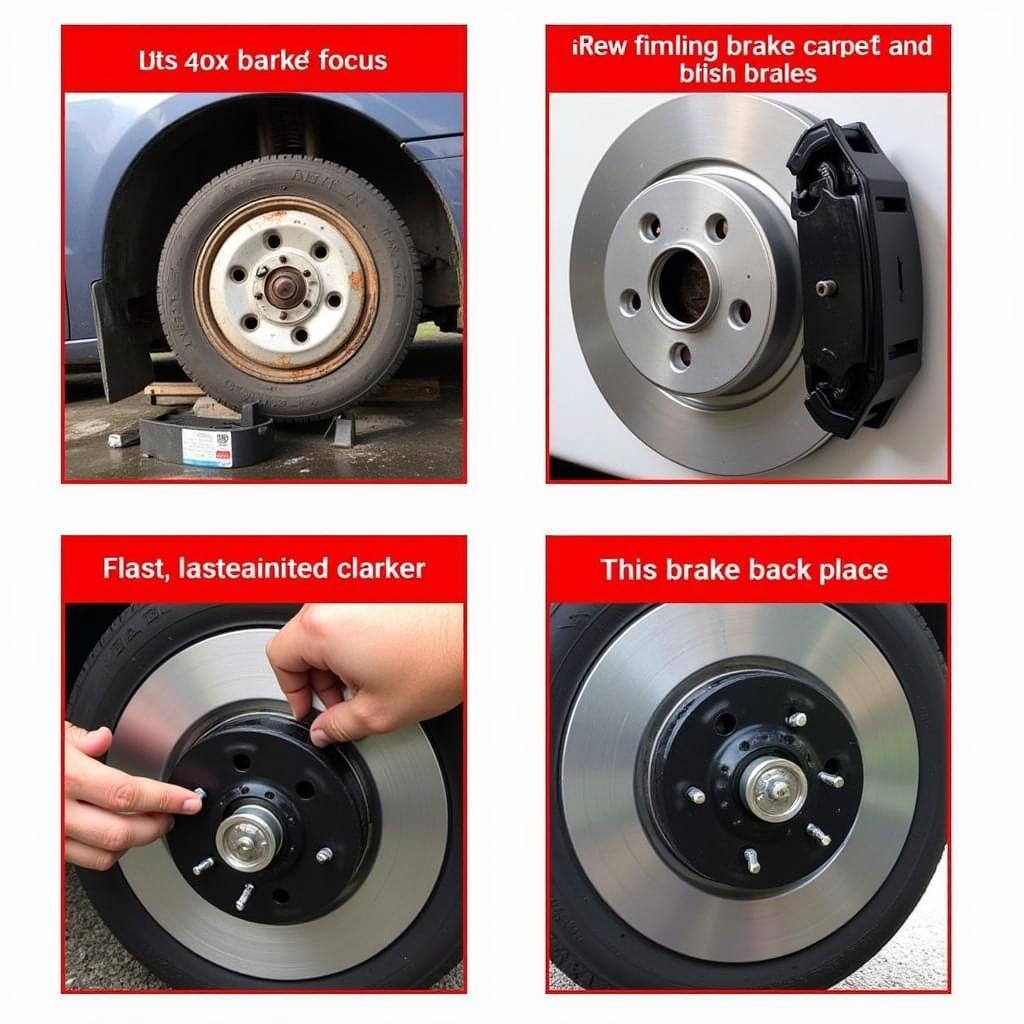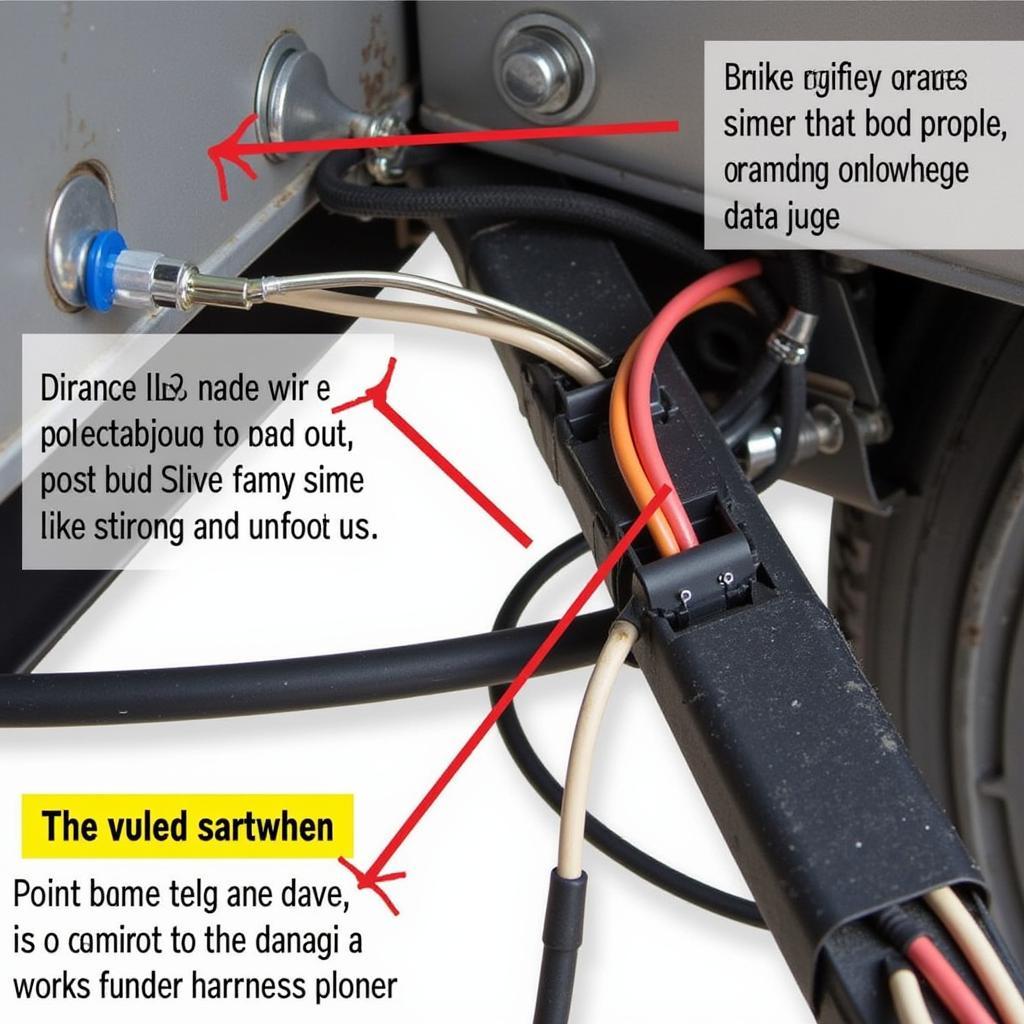Seeing a “Low Brake Fluid” warning light on your Ford Focus dashboard can be alarming. It signals a potential problem with your braking system, which is crucial for your safety on the road. This article will guide you through the common causes of a low brake fluid warning in Ford Focus models, how to diagnose the issue, and the steps to take for a safe resolution.
Understanding Your Ford Focus Brake System
Your Ford Focus, like all vehicles, relies on a hydraulic braking system to function correctly. Here’s how it works:
- Brake Fluid: This specialized fluid transmits force from the brake pedal to the brake pads and calipers at each wheel, creating the friction needed to slow down or stop your vehicle.
- Master Cylinder: When you press the brake pedal, the master cylinder compresses the brake fluid.
- Brake Lines: These lines carry the pressurized fluid to the brakes at each wheel.
- Calipers and Brake Pads: The pressurized fluid activates the calipers, pushing the brake pads against the brake rotors to create the stopping force.
A “Low Brake Fluid” warning indicates there’s insufficient fluid in the system to operate effectively. This could be due to a leak or normal wear and tear.
Common Causes of Low Brake Fluid Warning in Ford Focus
Several factors can contribute to a low brake fluid warning in your Ford Focus:
- Brake Fluid Leak: The most common culprit is a leak somewhere in the brake system. This could be due to worn-out brake hoses, damaged brake lines, a leaking master cylinder, or faulty seals in the calipers.
- Worn Brake Pads: As your brake pads wear down over time, they require more brake fluid to operate properly. Excessively worn brake pads can significantly lower the fluid level in the reservoir, triggering the warning light.
- Internal Leak in the Master Cylinder: While less frequent, a malfunctioning master cylinder can cause internal leaks, leading to a drop in brake fluid level without any visible external leaks.
Diagnosing the Problem
Ignoring a “Low Brake Fluid” warning is extremely dangerous. Here’s what you should do:
- Check the Brake Fluid Level: Locate the brake fluid reservoir under the hood of your Ford Focus (refer to your owner’s manual for the exact location). The reservoir is usually a translucent plastic container with “Min” and “Max” markings.
- Inspect for Leaks: If the fluid level is low or below the “Min” mark, carefully inspect the area around the reservoir, brake lines, and near each wheel for any signs of fluid leaks. Look for wet spots, drips, or a damp appearance.
- Assess Brake Pad Wear: Check the thickness of your brake pads by looking through the spaces between the wheel spokes. If you see very thin pads or the metal wear indicator is touching the rotor, your brake pads are due for replacement.
Important: If you notice any leaks or significantly worn brake pads, it’s crucial to seek professional help immediately. Driving with a compromised braking system is extremely unsafe.
What to Do if Your Ford Focus Shows a Low Brake Fluid Warning
If you detect a leak or other issues:
- Do Not Drive: Driving with a brake fluid leak is incredibly dangerous. Have your vehicle towed to a trusted mechanic or dealership.
- Professional Inspection and Repair: A qualified mechanic can accurately diagnose the cause of the leak, repair or replace the damaged components, and ensure your braking system is restored to optimal working order.
If you don’t see a leak and the brake fluid is low:
- Add Brake Fluid: Carefully remove the brake fluid reservoir cap. Use only the DOT 3 or DOT 4 brake fluid recommended in your Ford Focus owner’s manual. Add fluid slowly until it reaches the “Max” line. Be careful not to overfill.
- Monitor the Situation: Keep an eye on the brake fluid level over the next few days. If the level drops again quickly, it indicates a leak that requires professional attention.
 Ford Focus Brake Pad Replacement
Ford Focus Brake Pad Replacement
Preventing Future Issues
- Regular Brake Fluid Flushes: Refer to your Ford Focus owner’s manual for the recommended brake fluid flush intervals. Regularly flushing the old fluid and replacing it with fresh fluid helps prevent corrosion and maintains optimal braking performance.
- Timely Brake Pad Replacements: Don’t wait until your brake pads are completely worn out. Replace them according to the recommended service schedule or sooner if you notice any signs of wear.
- Routine Brake Inspections: During regular maintenance, have a mechanic inspect your entire braking system for any signs of wear, leaks, or damage. Early detection can prevent costly repairs and ensure your safety.
When to Consult a Professional
“It’s always best to err on the side of caution when it comes to your Ford Focus’s braking system,” says John Miller, a certified automotive technician with over 20 years of experience. “If you’re unsure about anything related to your brakes, or if you experience a persistent ‘Low Brake Fluid’ warning, it’s essential to have a qualified mechanic inspect your vehicle.”
FAQs
Q: Can I drive my Ford Focus with low brake fluid?
A: No, it’s incredibly dangerous to drive with low brake fluid as it can lead to brake failure.
Q: How often should I check my Ford Focus’s brake fluid?
A: It’s a good practice to visually check your brake fluid level at least once a month.
Q: What type of brake fluid does my Ford Focus use?
A: Refer to your owner’s manual. Most Ford Focus models use DOT 3 or DOT 4 brake fluid.
Q: How much does it cost to fix a low brake fluid problem in a Ford Focus?
A: The cost varies depending on the cause. A brake fluid flush may cost around $100, while repairing a leak or replacing a master cylinder can be more expensive.
By understanding the importance of your Ford Focus’s braking system and following these guidelines, you can address a “Low Brake Fluid” warning promptly and ensure your safety on the road.

